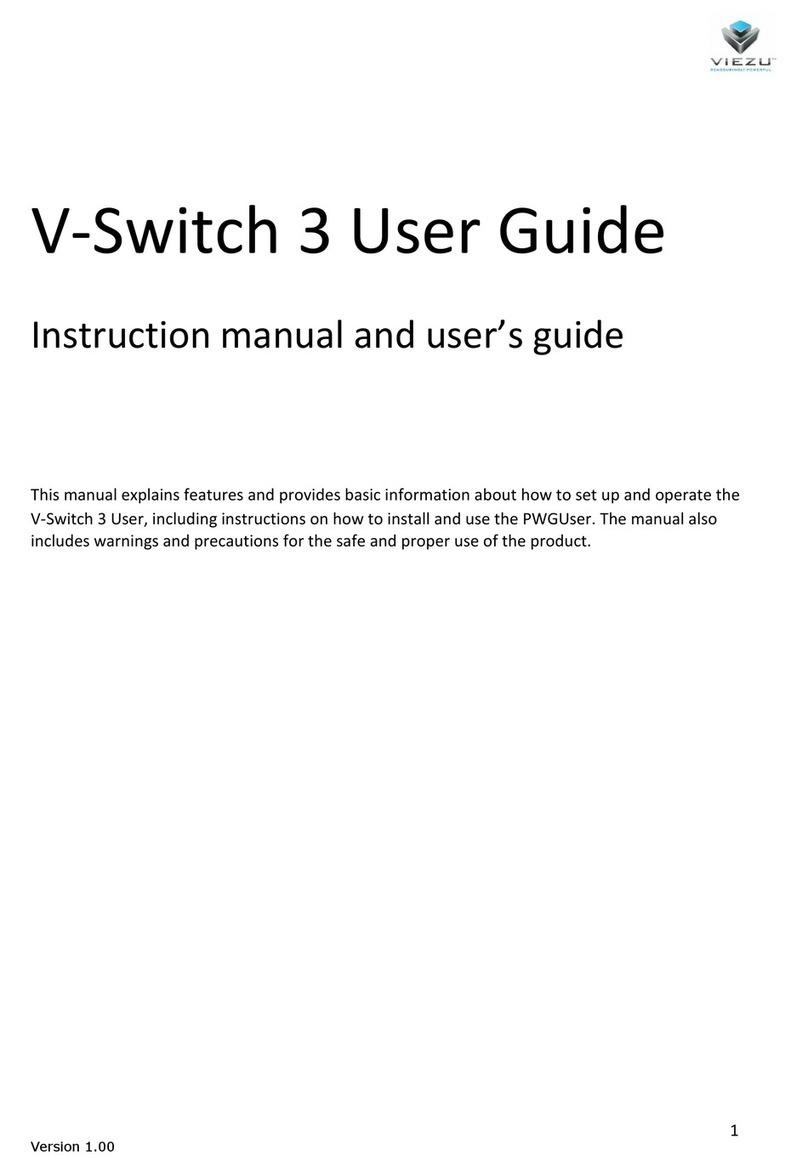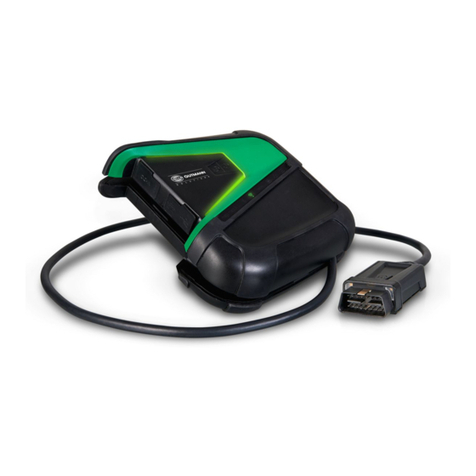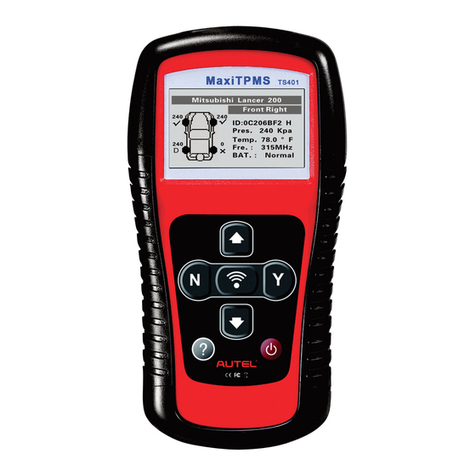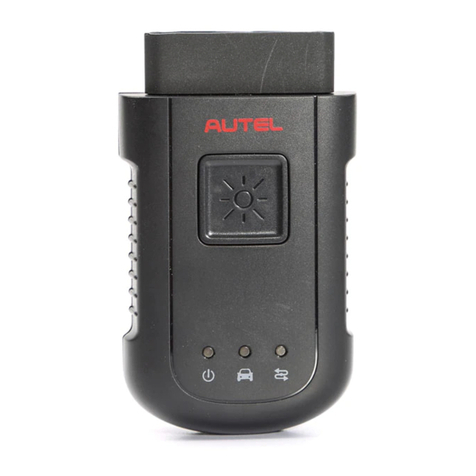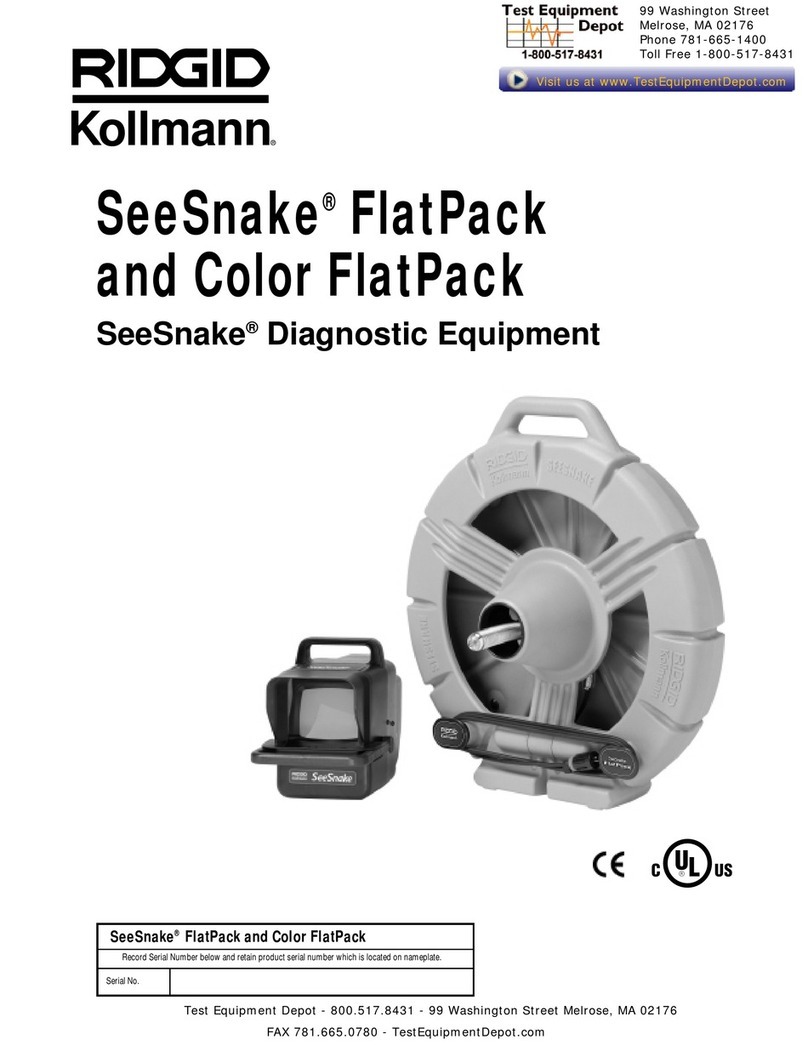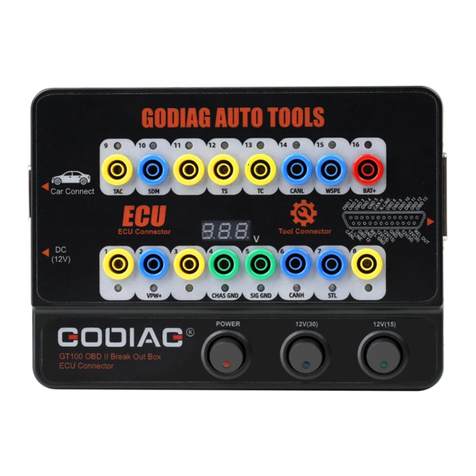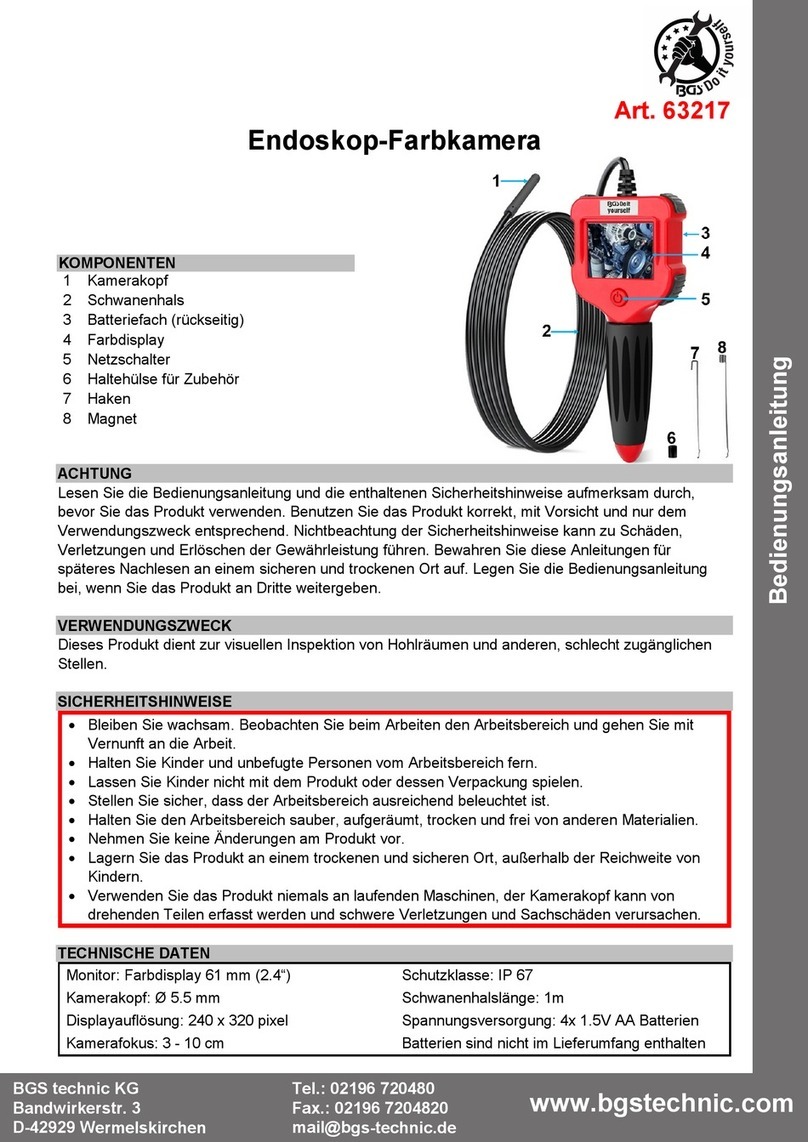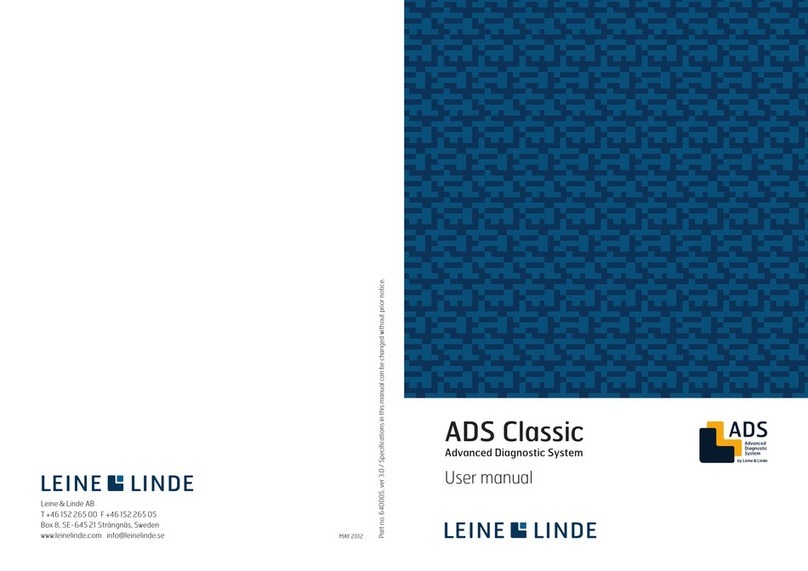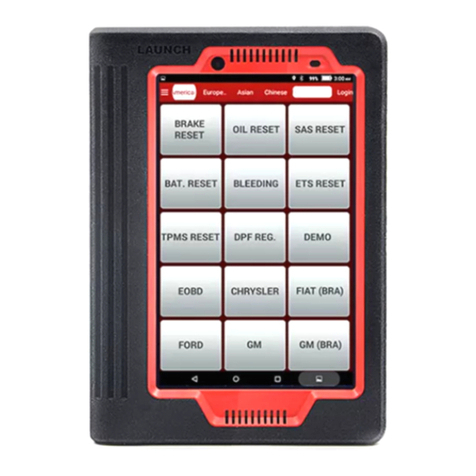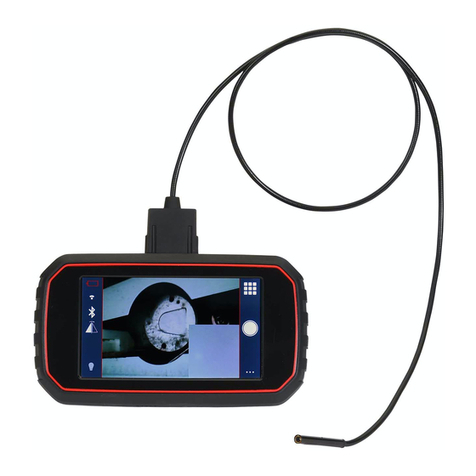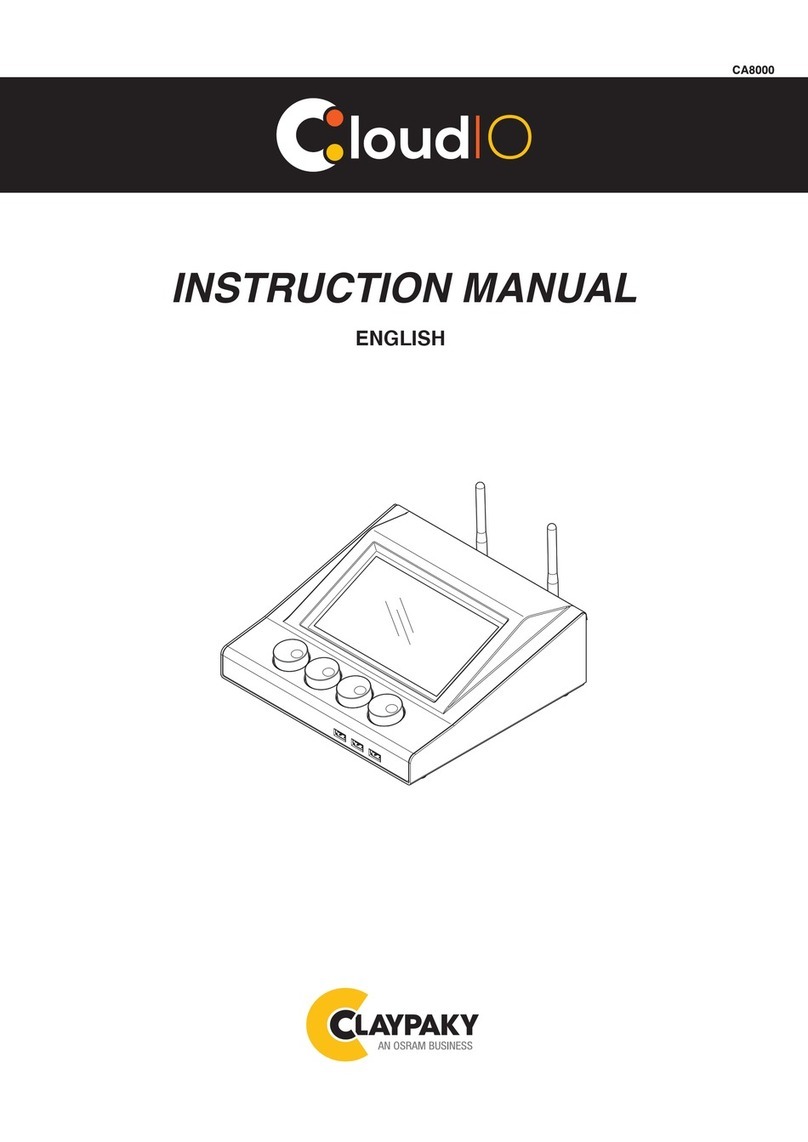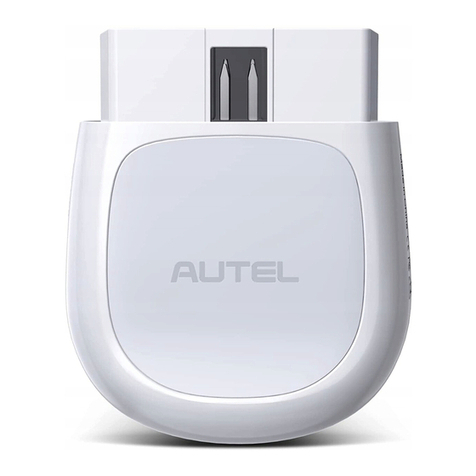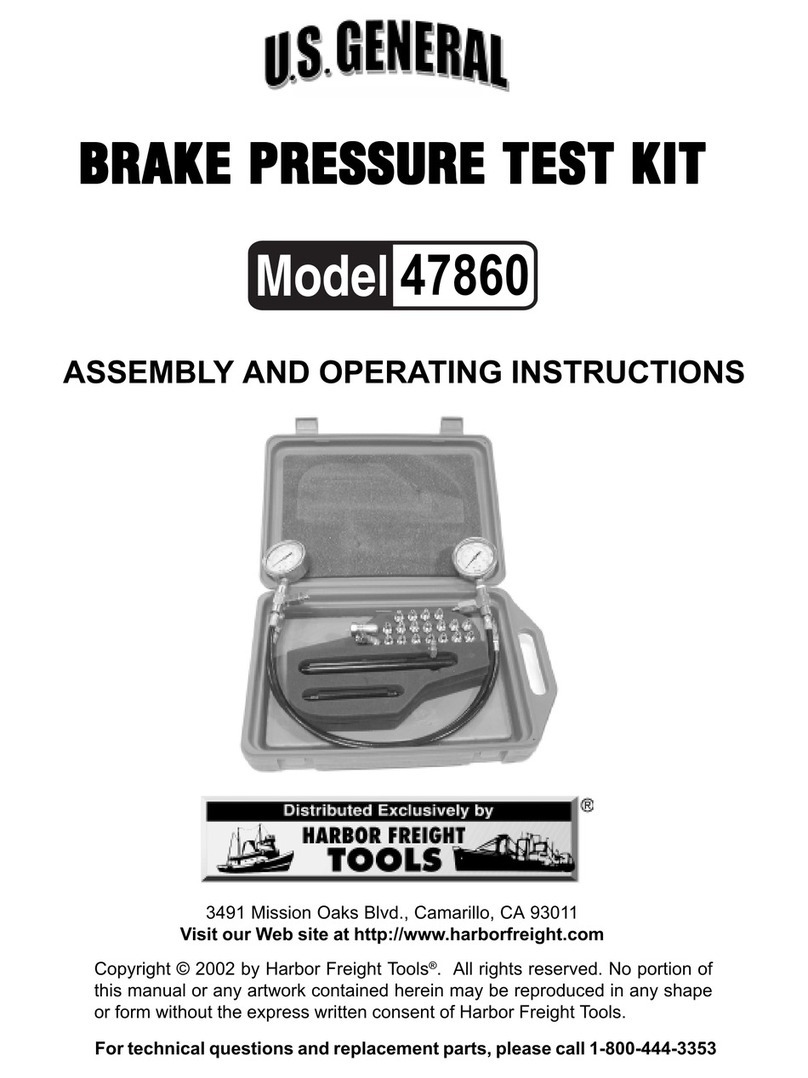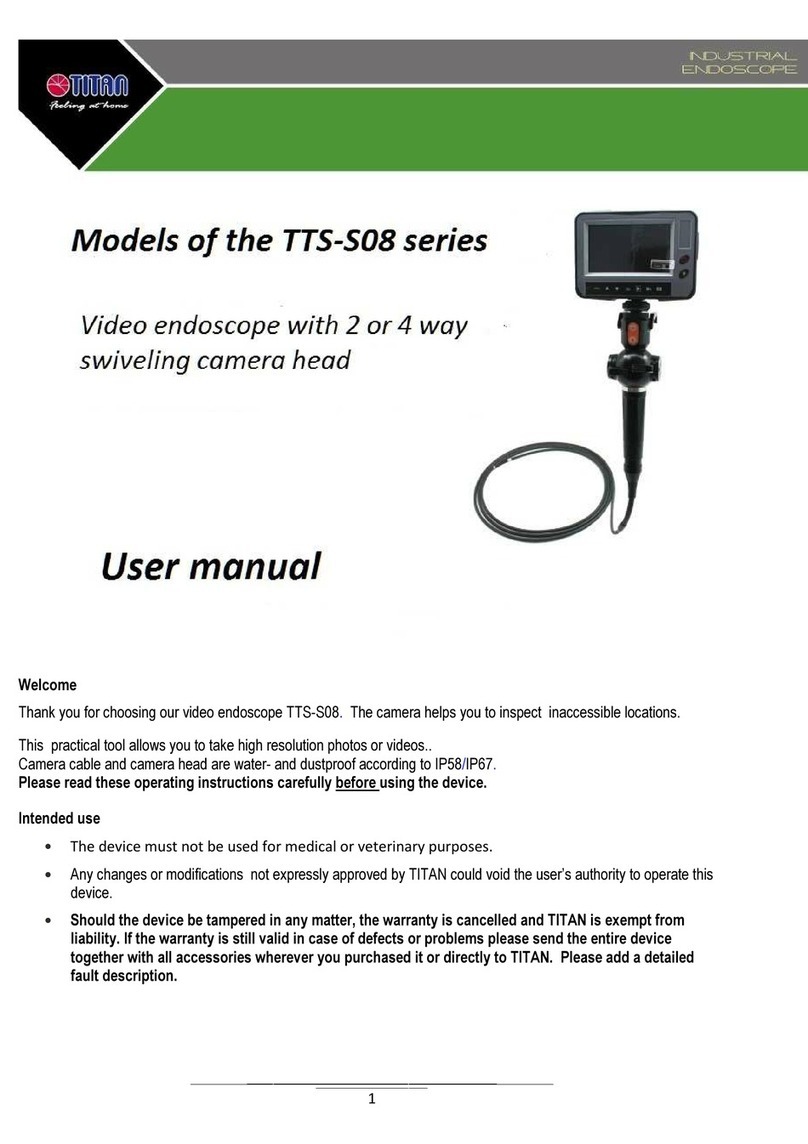ETView VivaSight SL User manual

By ETView
VIVASIGHT-SL
For use by trained personnel only
For use only with Ambu® aViewTM monitor
Instructions for Use

2
EN
BG
CS
DA
DE
EL
ES
ET
FI
FR
HR
HU
IT
JA
KO
LT
LV
NL
NO
PL
PT
RO
RU
SK
SL
SV
TR
ZH

Instructions for use –For use by trained personnel only........................................................................... 4
Упътване за употреба –За употреба само от обучен персонал....................................................14
Návod k použití –Prostředek je určen pouze k použití zaškolenými osobami............................... 22
Brugsvejledning
–
Må kun anvendes af uddannet personale............................................................... 29
Bedienungsanleitung –Nur zur Verwendung durch geschultes Personal....................................... 35
Οδηγίες χρήσης –Για χρήση μόνο από κατάλληλα εκπαιδευμένο προσωπικό.............................43
Instrucciones de Uso
–
para uso exclusivo de personal capacitado ...................................................51
Kasutusjuhised –Ainult väljaõppinud personalile kasutamiseks.......................................................... 58
Käyttöohjeet –Vain koulutetun henkilöstön käyttöön ............................................................................. 64
Mode d'Emploi
–
Conçu pour du personnel formé uniquement ............................................................71
Upute za uporabu –Uporaba je namijenjena samo obučenom osoblju............................................79
Használati utasítás –Kizárólag szakképzett személyzet általi használatra....................................... 86
Istruzioni per l'uso –Per l'uso esclusivo da parte di personale addestrato...................................... 93
取扱説明書
–
必ず訓練を受けた担当者のみが使用すること...........................................................
100
사용 지침: 훈련을 받은 전문인만 사용할 수 있음 ................................................................................
107
Naudojimo instrukcijos –Prietaisas skirtas naudoti tik apmokytiems darbuotojams
........................... 113
Lietošanas instrukcijas –Drīkst lietot tikai apmācīts personāls.............................................................119
Gebruiksaanwijzing –Alleen worden gebruikt door getrainde medewerkers...............................126
Bruksanvisning
–
Skal kun brukes av opplært personell....................................................................... 133
Instrukcja obsługi – produkt może być używany wyłącznie przez przeszkolony personel
.........139
Instruções de utilização
–
Para utilização exclusiva de pessoal qualificado ..................................146
Instrucțiuni de utilizare –destinat pentru utilizarea exclusiv de către personal instruit.....................
153
Инструкция по эксплуатации –Для использования только специально обученным персоналом... 160
Návod na použitie –určené na použitie výlučne vyškoleným personálom.....................................168
Navodila za uporabo –le za usposobljeno osebje.................................................................................. 175
Användarinstruktioner
–
Uteslutande för användning av utbildad personal.................................... 181
Kullanım talimatları –sadece eğitimli personel tarafından kullanıma uygundur.............................188
使用说明 – 只能由经过培训的人员操作......................................................................................................195
EN
BG
CS
DA
DE
EL
ES
ET
FI
FR
HR
HU
IT
JA
KO
LT
LV
NL
NO
PL
PT
RO
RU
SK
SL
SV
TR
ZH
EN
BG
CS
DA
DE
EL
ES
ET
FI
FR
HR
HU
IT
JA
KO
LT
LV
NL
NO
PL
PT
RO
RU
SK
SL
SV
TR
ZH
3

4
ENGLISH
STERILE (ETO) unless package has been
opened or damaged.
DO NOT REUSE.
Federal (US) law restricts this device to
sale by or on the order of a physician.
DESCRIPTION
Note: VivaSight-SL is the brand name for
the ETView Tracheoscopic Ventilation
Tube (TVT
TM
).
VivaSight-SL is a single-use, cuffed PVC
endotracheal tube with an embedded
video imaging device and light source
at its tip, and an integrated single use
video/power cable (adapter cable) with
connector. VivaSight-SL displays images
of the airway onto the Ambu® aViewTM
monitor for as long as the device remains
in place during intubation.
VivaSight-SL has two Murphy eyes flanking
the 45° bevel tip. In addition to the cuffed
inflation tube, VivaSight-SL has an injection
port for imaging lens cleaning that leads to
two lumens running along the tube’s wall
and opens distally to the imaging lens.
The port is used for cleaning the lens with
air, saline, or other appropriate solutions.
INDICATIONS FOR USE
The ETView Tracheoscopic Ventilation
Tube (TVTTM) is intended for intubation
procedures. The ETView Tracheoscopic
Ventilation Tube (TVTTM) is indicated for
use as a temporary artificial airway in
adults requiring mechanical ventilation.
It is intended for oral and nasal intubations.
The TVTTM System is indicated for
viewing during non-difficult and difficult
intubation procedures, for verifying
endotracheal tube and endobronchial
blocker placement and repositioning,
for viewing during suctioning and for
general inspection of the airway.
CONTRAINDICATIONS
Do not use laser equipment in the
immediate proximity of the VivaSight-SL.
ACCESSORIES
Stylet
WARNINGS
• VivaSight-SL is a single use product.
Do not reuse: After use, handle and
dispose according to local regulations
for disposal of infected medical devices.
Reuse of this single use product may
create a potential risk to the user.
Reprocessing, cleaning, disinfection
and sterilization may compromise
product characteristics which in turn
create an additional risk of physical
harm to or infection of the patient.
• Do not attempt to resterilize any part
of VivaSight-SL.
• Do not connect VivaSight-SL into
any device or outlet other than those
supplied by ETView or Ambu.
• The intended performance of the
VivaSight-SL is reached only with the
disposable devices and accessories
provided or specified by Ambu or
ETView.
•
VivaSight-SL is available in tube sizes of
7 mm, 7.5 mm and 8 mm (internal
diameter) and should be used for
patients who require one of these sizes.
• Do not use the injection port for
suctioning the patient.
• The cuff pressure should not exceed
25 cm H2O. Diffusion of a nitrous oxide
mixture, oxygen, or air may either
increase or decrease the cuff pressure.
• Do not use the camera in the event
that inspired gas temperature exceeds
34 °C for an artificially ventilated patient.
•
Do not overinflate the cuff. Overinflation
can result in tracheal damage, rupture
of the cuff with subsequent deflation,
or cuff distortion, which may lead to
airway blockage.
• Do not use the tube if the cuff is
damaged. Care must be taken to avoid
damaging the cuff during intubation.
• Do not use the tube if the cuff is
damaged. Various bony anatomical
structures such as teeth, or any intubation
aid with sharp surfaces in the intubation
VIVASIGHT EB
VIVASIGHT-SL

path can damage cuff intregrity.
Care
must be taken to avoid damaging the
thin-walled cuff during intubation, which
may result in the patient requiring
traumatic extubation and reintubation.
• The cuff needs to be completely
deflated prior to repositioning the
tube. Movement of the tube with an
inflated cuff may result in damage to
the cuff or in patient injury, which may
result in medical interventions.
•
If the tube is lubricated prior to intubation,
it is essential to verify that the lubricant
has not entered or occluded the tube
lumen or cuff-filling system, thereby
preventing ventilation or damaging the
cuff. Ventilation and proper functioning
of the cuff may be impaired.
•
Reliance on the graduated black depth
marks on the tube should not substitute
for expert judgment. The user should
be aware of anatomical variations,
including the length of the airway.
Intubation and extubation should
be performed following currently
accepted medical techniques.
• VivaSight-SL’s location should be
verified every time the patient is
moved. Should extreme flexion of the
head (chin-to-chest) or movement of
the patient (e.g., to lateral or prone
positions) occur after intubation, ensure
that VivaSight-SL remains in place.
• Do not use an intubation stylet other
than provided with the VivaSight-SL.
• Electronic equipment and the
VivaSight-SL system may affect the
normal function of each other. If the
VivaSight-SL system is used adjacent
to or stacked with other equipment,
observe and verify normal operation
of both the VivaSight-SL system and
the other electronic equipment prior
to using it. It may be necessary to
adopt procedures for mitigation,
such as reorientation or relocation
of the equipment or shielding of
the room in which it is used. Consult
the tables in appendix 1 (English
version) for guidance in placing the
VivaSight-SL system.
• Portable RF communications
equipment (including peripherals
such as antenna cables and external
antennas) should be used no closer
than 30 cm (12 inches) to any part of
the system, including cables specified
by the manufacturer. Otherwise,
degradation of the performance of
this equipment could result.
• The VivaSight-SL is not to be
used when delivering flammable
anaesthetics to the patient. This could
potentially cause patient injury.
• Be careful to check whether the
image on the screen is a live image
or a recorded image.
• The surface temperature of the
VivaSight-SL is likely to reach above
43 °C when the tube is placed outside
the patient. Therefore switch off the
monitor after the preuse test and
switch it back on immediately before
use, to prevent the risk of having an
impact on the tissue. The surface
temperature on the Adapter Cable is
likely to reach between 41 °C and 43 °C.
•
Prior to use, check that the pouch seal
is intact and there are no impurities or
damage on the product such as rough
surfaces, sharp edges or protrusions
which may harm the patient.
CAUTIONS
•
Use of HF equipment in the immediate
proximity of the Vivasight SL may lead
to impaired image quality.
• To ensure secure placement once
the connector has been loosened
or removed, the connector and the
corresponding part of the tube shall
be cleaned with ethanol prior to
reconnecting the connector.
•
Adapter Cable and connectors shall be
kept away from patient face to avoid
facial harm.
• VivaSight-SL is intended for use by
trained personnel only.
•
Use the same size VivaSight-SL as the
required standard tube size. Expert
clinical judgment should be used in
5

6
ENGLISH
choosing the suitable tracheal tube
size and stylet for each patient.
• Do not use instruments within the
lumen with diameter larger than
indicated in the following table:
• When VivaSight-SL is used with
9 Fr EBB (e.g., VivaSight-EB), the
bronchoscope sizes should not be
larger than:
• Do not use suction catheters
larger than:
• Do not immerse the tube in liquid.
• The use of lidocaine topical aerosols
has been associated with the
formation of pinholes in PVC cuffs*.
To prevent cuff leaks, expert clinical
judgment is required when using
lidocaine topical aerosols.
• Use only water-soluble lubricants.
Other lubricants might affect the cuffs.
• Avoid applying lubricants to the front
of the camera or the inside of the tube,
due to risk of affecting ventilation.
• Use a cuff pressure gauge to help
monitor and adjust the cuff pressure.
Inflation of the cuff by “feel” alone or
by using a measured volume of air
is not recommended as resistance is
an unreliable guide during inflation.
• Syringes, stopcocks, or other devices
should not be left in the inflation
system for an extended period.
• Do not connect VivaSight-SL to any
external monitor equipment other
than aView.
* Jayasuriya KD, Watson WF: “P.V.C.
cuffs and Lidocaine-based aerosol”;
Br J Anaesth
. 1981 Dec; 53 (12): 1368.
MRI CONDITIONS
Non-clinical testing has demonstrated
that VivaSight-SL is MRI conditional. It can
be scanned safely under the following
conditions:
• Static magnetic field of 3 tesla or less.
• Spatial gradient field of 720 gauss/
cm or less.
• Maximum specific absorption rate
(SAR) of 4 W/kg for 15 minutes.
Under these conditions, VivaSight-SL
produces a maximum temperature rise
of 0.6 °C.
During MRI scanning, disconnect
VivaSight-SL from the single use adapter
cable and aViewTMmonitor, as it may be
subject to movement caused by the
magnetic field.
MRI image quality may be compromised
if the area of interest is in the exact area
or relatively close to the position of the
camera, VivaSight-SL connector, or cuff
inflation port.
STORAGEANDTRANSPORTATION
• Store and transport VivaSight-SL
at temperatures between 0 °C and
42 °C, relative humidity between
10-100% and atmospheric pressure
between 80-109 kPa.
• Store in a dry, cool and dark place.
ADVERSE EVENTS
Adverse events associated with the use
of VivaSight-SL are the same as those of
Product Diameter no
larger than
VivaSight-SL 7 mm 19 Fr
VivaSight-SL 7.5 mm 20 Fr
VivaSight-SL 8 mm 22 Fr
Product + EBB 9 Fr Bronchoscope
no larger than
VivaSight-SL 7 mm
+ EBB 9 Fr 9 Fr
VivaSight-SL 7.5 mm
+ EBB 9 Fr 10 Fr
VivaSight-SL 8 mm
+ EBB 9 Fr 12 Fr
Product Suction catheter
no larger than
VivaSight-SL 7 mm 19 Fr
VivaSight-SL 7.5 mm 20 Fr
VivaSight-SL 8 mm 22 Fr

standard endotracheal tubes. The most
common are laryngospasm; vocal cord
paralysis; injuries to lips, gums, tongue,
teeth; and aspiration of gastric contents.
Consult scientific literature for specific
adverse reaction information.
Adverse events associated with use of
standard endotracheal tubes, are fracture
or dislocation of the cervical spine,
endobronchial or esophageal intubation,
perforation of the trachea or esophagus,
and failed intubation.
TECHNICAL SPECIFICATIONS
The VivaSight-SL is an electrical safety
defibrillation-proof type BF applied part.
• Imaging sensor: CMOS
• Resolution: CIF 320 x 240
• Video format: NTSC Composite
Video Baseband Signal (CVBS)
• Light source: 2 LEDs (integrated)
• FOV: Horizontal ~76°, Vertical ~56°,
Diagonal ~100°
• Focusing range: 12 mm–60 mm
• Power: up to 36 mA @ DC 5V
• Operating ambient temperature:
10-37 °C (50-98 °F)
• Operating relative humidity: 30-75%
• Operating atmospheric pressure:
80-109 kPa
• Operating altitude: ≤2000 m
INTUBATION
RECOMMENDATIONS
Intubation with VivaSight-SL is
performed according to currently
accepted medical techniques.
The tube position should be inside the
trachea above the main carina.
•
Laryngoscope: With VivaSight-SL, use
of the laryngoscope may be gentler. It
can be used to just hold the tongue.
• Stylet: The accompanying stylet is
used to make VivaSight-SL more rigid,
for use with or without laryngoscope.
• Oral/Nasal: Approved for oral and
nasal intubation procedures.
PREINTUBATION PREPARATION
CHOOSING VIVASIGHT-SL SIZE
• Use the same size VivaSight-SL as
standard required endotracheal
tube size.
• Use expert clinical judgment
when choosing tracheal tube size for
each patient.
CONNECTING THE TUBE,
VERIFICATION STEPS &
PREPARATION FOR INTUBATION
1. Connect VivaSight-SL to the single
use adapter cable. Be careful to align
the white arrow on the single use
adapter cable with the arrow on the
VivaSight-SL tube round connector.
2. Connect the single use adapter cable
to the aView™ monitor, be careful to
align the arrow on the cable with the
arrow indicator on the aView
TM
monitor.
Verify that all electrical connections are
stable and secure. Refer to aView™
monitor instructions for use.
3. Press the power button on top of the
aView
TM
monitor for at least one second
until a live image appears. Refer to
aView
TM
monitor instructions for use. The
aViewTM
monitor user interface will be
ready after approximately one minute,
when the hourglass symbol disappears.
During this time, proceed with the
verification steps.
4. Check that the two LEDs at the
tip of the tube are illuminated.
If they are not illuminated, replace the
tube with another.
5. Verify that there is a stable image on
the aViewTM monitor (projected from
the tip of VivaSight-SL). Then turn off
the monitor again until immediately
prior to intubation.
6. Test the cuff for integrity by inflating
and deflating it completely.
7. Become familiar with the feel of the
tube and clear pilot balloon.
8. Induce anesthesia, as per protocol.
Recommendation: Use a ventilator
circuit holder to prevent VivaSight-SL
from kinking.
7

8
ENGLISH
9.
Suction the oral cavity and airway area
before inserting VivaSight-SL.
10. Prepare the patient, and lubricate the
tube (if needed), avoiding the area
around the camera lens at the distal
end of VivaSight-SL.
11. Intubate the patient and remove the
stylet. In case of obstructed or obscured
view, see “Cleaning the Lens”.
DEPTH SCALING
Note: Suggested depth is 2 cm to 3 cm
above the main carina. VivaSight-SL has
been used at greater depths for one
lung ventilation, but keep in mind that
VivaSight-SL’s electronic wire is outside
the protective lumen at 28 cm to 30 cm.
Like with most intubation tubes, a series
of depth marks appear on the side of
VivaSight-SL.
Depth marks range from 12 cm to 28 cm,
in 2 cm increments.
To determine a specific depth, gauge from
the carina:
1. Insert VivaSight-SL’s camera up to the
depth of the carina.
2.
Look at VivaSight-SL’s depth marks on
the side of the tube.
3. Pull VivaSight-SL back from the carina
to the desired depth.
VISIBILITY DURING PROCEDURE
In the unlikely event that the image is not
shown during a procedure, disconnect
the VivaSight-SL from the single use
adapter cable to the aViewTM monitor
and continue to use VivaSight-SL as a
standard airway tube. Do not attempt to
fix the connection or replace the aView
TM
monitor. Turn off the aView
TM
monitor and
dispose of the single use adapter cable.
CLEANING THE LENS
If VivaSight-SL’s lens becomes soiled
or obscured by secretions, it can be
cleaned by injecting air, prescribed liquid
medications, or saline, where permitted
by institutional policy, into the injection
port of the rinsing tube.
Recommended lens cleaning method:
1. Inject 20cc air into the injection tube
port (RED), and then check image clarity.
2. If the image is not sufficiently clear,
connect a 10cc syringe filled with 2cc
of Saline, to the flushing port and push
the plunger. Perform this step twice
(total of 4cc of Saline).
3. Fill a 10cc syringe with 5-10cc of air,
connect it to the flushing port and push
the plunger. Perform this step twice.
4. Connect an empty 10cc syringe, to
the flushing port and suck the Saline.
Perform this step twice.
ADDITIONAL NOTES
• Continuous viewing of the airway
enables real-time verification of the
tube position, early detection of
adverse airway events, and secretion
management under visual guidance.
• Suctioning: VivaSight-SL can be
suctioned normally, as required,
using a catheter size as indicated in
“Cautions” above.
• Specialty suction catheters may be
used to facilitate gentle selective
suctioning of the left and right main
stem bronchi.
• Validation: During static situations
where VivaSight-SL is in place, and the
patient is not being moved, validation
that the system is operating must be
performed periodically by observing
breathing movements and cardiac
pumping movement in the image on
the aViewTM monitor.
• The device usage time function on
the
aViewTM
monitor is not available
for VivaSight-SL. For this device, the
device usage time will always display
“00:00:00”. This will not affect the
functioning of the system.
EXTUBATION
• Deflate the cuff completely, as per
protocol.
• Extubation is performed slowly, while
examining the airway on the aView™
monitor one last time (document or
record, as necessary).

DISCONNECTING VIVASIGHTSL
1. Disconnect the single use adapter
cable from the aView™ monitor.
2. Turn off the aView™ monitor by
pressing the power button for at least
two seconds.
DISPOSAL
Discard the single use VivaSight-SL tube,
stylet and adapter cable in a suitable
biohazard receptacle in accordance with
local regulations.
For disposal instructions for the aView™
monitor, refer to aView™ monitor
instructions for use.
CONTAINS DEHP
The results of certain animal experiments
have shown phthalates to be potentially
toxic to reproduction. Proceeding from the
present state of scientific knowledge, risks
for premature infants cannot be excluded
in the case of long-term exposure or
application. Medical devices containing
phthalates should be used only
temporarily with pregnant women, nursing
mothers, babies and infants.
PHT
DEHP
MANUFACTURED BY:
ETView Ltd.
Catom 2 Street
Misgav Business Park
M.P. Misgav 2017900, Israel
www.etview.com
LB10016 REV02
Manufacture
Date
Expiry
Date
Consult instructions for use
Do not use if package is
damaged
Do not reuse
Sterilized Using
Ethylene Oxide
Non-sterile (single use
adapter cable only)
US Federal law restricts this
device to
sale by or on the
order of a physician
Defibrillation-proof type BF
applied part
MR
Conditional
PHT
DEHP
Contains
DEHP
Temperature for
transportation and storage
100%
Humidity for transportation
and storage
109kPa
Pressure for transportation
and storage
STERILIZE
REF LOT
Manufacturer
EC REP
Authorized Representative
in the European
Community
Waste Bin Symbol
This product is not made
with natural rubber latex
REF
Reference Number
Lot Number, Batch Code
Caution
9

10
ENGLISH
APPENDIX 1. ELECTROMAGNETIC COMPATIBILITY
Like other electrical medical equipment the system requires special precautions to
ensure electromagnetic compatibility with other electrical medical devices. To ensure
electromagnetic compatibility (EMC) the system must be installed and operated according
to the EMC information provided in this manual.
The system has been designed and tested to comply with IEC 60601-1-2 requirements
for EMC with other devices.
Guidance and manufacturer’s declaration –
electromagnetic immunity
The system is intended for use in the electromagnetic environment specified
below. The customer or the user of the system should assure that it is used in
such an environment.
Emission Test Compliance Electromagnetic Environment
Guidance
RF emission
CISPR 11 Group 1 The system use RF energy only for
its internal function. Therefore, its RF
emissions are very low and are not
likely to cause any interference in
nearby electronic equipment.
RF emission
CISPR 11 Class B
The system is suitable for use
in all establishments, including
domestic establishments and those
directly connected to the public
low-voltage power supply network
that supplies buildings used for
domestic purposes.
Harmonic emission IEC/EN
61000-3-2 Not applicable
Voltage fluctuations / flicker
emissions IEC/EN 61000-3-3 Complies

Guidance and manufacturer’s declaration –
electromagnetic immunity
The system is intended for use in the electromagnetic environment specified
below. The customer or the user of the system should assure that it is used in
such an environment.
Immunity Test IEC 60601-1-2
test level Compliance Level Electromagnetic
environment -
guidance
Electrostatic
discharge (ESD)
IEC 61000-4-2
+/- 8 kV contact
+/- 2, 4, 8,
15 kV air
+/- 8 kV contact
+/- 2, 4, 8, 15 kV air
If floors are covered
with synthetic material
the relative humidity
shall be least 30%.
Electrical fast
transient / burst
IEC 61000-4-4
+/- 2 kV for mains
supply lines
+/- 1 kV for input /
output lines
+/- 2 kV mains
supply lines
N/A
Mains power quality
shall be that of a
typical commercial or
hospital environment.
Surge
IEC 61000-4-5
+/- 0.5, 1 kV
line(s) to line(s)
+/- 0.5, 1, 2 kV
line(s) to earth
+/- 0.5, 1 kV line(s) to
line(s), mains supply
+/- 0.5, 1, 2 kV
line(s) to earth,
mains supply
Mains power quality
shall be that of a
typical commercial or
hospital environment.
Voltage Dips,
short interruptions
and voltage
variations on
power supply
input lines
IEC 61000-4-11
0% Ut
(100% dip in Ut)
for 0.5 cycle at
8 angels
100% reduction
0.5 period at
8 angels
Mains power quality
shall be that of a
typical commercial or
hospital environment.
If the use of the
system requires
continued operation
during power mains
interruptions the
system can be
powered by the built in
rechargeable battery.
0% Ut
(100% dip in Ut)
for 1 cycle
100% reduction
for 1 period
70% Ut
(30% dip in Ut)
for 25 cycles
30% reduction
for 25 periods
0% Ut
(100% dip in Ut)
for 5 sec.
100% reduction
for 5 sec.
Power frequency
(50/60 Hz)
magnetic field
IEC 61000-4-8
30 A/m 30 A/m Power frequency
magnetic fields
should be at levels
characteristic of a
typical location in a
typical commercial or
hospital environment.
NOTE: Ut is the a.c. mains voltage prior to application of the test level.
11

12
ENGLISH
Guidance and manufacturer’s declaration
– electromagnetic immunity
The system is intended for use in the electromagnetic environment specified
below. The customer or the user of the system should assure that it is used in
such an environment.
Immunity test IEC 60601-1-2
test level
Compliance level
Electromagnetic
environment - guidance
Conducted
Radio
Frequency
IEC 61000-4-6
3 V RMS
0,15 MHz –
80 MHz
6 V RMS
in ISM bands
80% AM at 1 kHz
3 V RMS
0,15 MHz –
80 MHz
6 V RMS
in ISM bands
80% AM at 1 kHz
Portable and mobile RF
communications equipment
should be used no closer
to any part of the system,
including its cables, than the
recommended separation
distance calculated from
the equation applicable
to the frequency of the
transmitter.
Recommended separation
distance
d
= 1.17√
P
d
= 1.17√
P
80 MHz to 800
MHz
d
= 2.33√
P
800 MHz to
2.7 GHz
Where
P
is the maximum
output power rating of the
transmitter in watts (W)
according to the transmitter
manufacturer and d is the
recommended separation
distance in metres (m).
Field strengths from fixed RF
transmitters, as determined
by an electromagnetic site
survey, a) should be less
than the compliance level in
each frequency range b).
Interference may occur in
the vicinity of equipment
marked with the
following symbol.
Radiated
Radio
Frequency
IEC 61000-4-3
3 V/m 80-2700
MHz
80% AM at 1 kHz
Additional
proximity field test
frequencies and
levels according
to 60601-1-2
table 9
3 V/m 80-2700
MHz
80% AM at 1 kHz
Additional
proximity field test
frequencies and
levels according
to 60601-1-2
table 9
NOTE 1 At 80 MHz, the higher frequency range applies.
NOTE 2 These guidelines may not apply in all situations. Electromagnetic propagation
is affected by absorption and reflection from structures, objects and people.

Recommended Separation Distances Between Portable and Mobile
RF Communication Equipment and system
The system is intended for use in an electromagnetic environment in which
radiated RF disturbances are controlled. The user of the system can help prevent
electromagnetic interference by maintaining a minimum distance between
portable and mobile RF communications equipment (transmitters and the
system as recommended below, according to the maximum output power of the
communication equipment.
Rated maximum
output power (W)
of transmitter
Separation distance (m) according to
frequency of transmitter
150 kHZ to 80 MHz
d = 1.17√P
80 MHz to 800 MHZ
d = 1.17√P
800 MHz to 2.7 GHz
d = 2.33√P
0.01 0.12 m 0.12 m 0.23 m
0.1 0.37 m 0.37 m 0.74 m
1 1.17 m 1.17 m 2.33 m
10 3.70 m 3.70 m 7.37 m
100 11.7 m 11.7 m 23.3 m
For transmitters rated at a maximum output power not listed above, the recommended
separation distance (d) in meters (m) can be estimated using the equation applicable
to the frequency of the transmitter, where P is the maximum output power rating of the
transmitter in watts (W) according to the transmitter manufacturer.
Note 1: At 80 MHz and 800 MHz, the separation distance for the higher frequency
range applies.
Note 2:These guidelines may not apply in all situations. Electromagnetic propagation
is affected by absorption and reflection from structures, objects and people.
a) Field strengths from fixed transmitters, such as base stations for radio (celluar/
cordless) telephones and land mobile radios, amateur radio, AM and FM radio
broadcast, and TV broadcast, cannot be predicted theoretically with accuracy.
To assess the electromagnetic environment due to fixed RF transmitters, an
electromagnetic site survey shall be considered. If the measured field strength in
the location in which the system is used exceeds the applicable RF compliance
level above, the system shall be observed to verify normal operation. If abnormal
performance is observed, additional measures may be necessary, such as
reorienting or relocating the system.
b) Over the frequency range 150 kHz to 80 MHz, field strengths shall be less than 3 V/m.
13

14
БЪЛГАРСКИ
СТЕРИЛЕН (ETO), ако опаковката не
е отворена или повредена.
ДА НЕ СЕ ИЗПОЛЗВА ПОВТОРНО.
Федерално законодателство
(на САЩ) ограничава продажбата
на това устройство от или по
предписание на лекар.
ОПИСАНИЕ
Забележка: VivaSight-SL е името на
марката за трахеоскопична тръба за
вентилация (TVT
TM
) на ETView.
VivaSight-SL е PVC ендотрахиална
тръба с маншон за еднократна
употреба с вградено устройство
за получаване на видеообраз и
светлинен източник на върха и
вграден видео/захранващ кабел
(адапторен кабел) за еднократна
употреба с конектор. VivaSight-SL
показва изображения от дихателните
пътища на монитор Ambu® aViewTM
докато устройството остава на мястото
по време на интубация.
VivaSight-SL има две „очи на Мърфи“,
съпътстващи връх, скосен на 45°. В
допълнение към тръбата с надуващ
се балон VivaSight-SL има порт
за инжектиране за почистване на
визуализиращите лещи, който води към
двата лумена по протежение на стената
на тръбата и се отваря дистално към
визуализиращите лещи. Портът се
използва за почистване на лещите с
въздух, физиологичен разтвор или
други подходящи разтвори.
ПОКАЗАНИЯ ЗА УПОТРЕБА
Трахеоскопичната тръба завентилация
(TVTTM) на ETView е предназначена
за използване при процедури за
интубация. Трахеоскопичната тръба
за вентилация (TVTTM) на ETView е
предназначена за използване като
временен изкуствен дихателен път
при възрастни, изискващи механична
вентилация. Тя е предназначена за
орална и назална интубация.
Системата TVTTM е предназначена за
употреба за наблюдение по време на
незатруднени и затруднени процедури
на интубиране, за проверка при
поставяне на ендотрахеалната тръба
и ендобронхиален блокер и при
препозициониране, за наблюдение
по време на аспириране и за обща
проверка на дихателните пътища.
ПРОТИВОПОКАЗАНИЯ
Да не се използва лазерно
оборудване в непосредствена
близост на VivaSight-SL.
АКСЕСОАРИ
Стилет
ПРЕДУПРЕЖДЕНИЯ
• VivaSight-SL е продукт за
еднократна употреба. Да
не се използва повторно:
След употреба обработете и
унищожете съгласно местните
разпоредби за унищожаване
на инфектирани медицински
изделия. Повторната употреба
на този продукт за еднократна
употреба може да създаде
потенциален риск за потребителя.
Повторната обработка, почистване,
дезинфекция и стерилизация могат
да компрометират продуктовите
характеристики, които на свой
ред създават допълнителен риск
от физическо увреждане или
инфекция на пациента.
• Не се опитвайте да стерилизирате
повторно която и да е част от
VivaSight-SL.
• Не свързвайте VivaSight-SL към
каквото и да е изделие или извод,
различни от такива доставени от
ETView или Ambu.
•
Работата, за която е предназначено
устройството VivaSight-SL, се
постига само с изделията и
аксесоарите за еднократна
употреба, предоставени или
определени от Ambu или ETView.
VIVASIGHT EB
VIVASIGHT-SL

15
• VivaSight-SL се предлага с тръби
с размери 7 мм, 7,5 мм и 8 мм
(вътрешен диаметър) и трябва да
се използват при пациенти, които
изискват един от тези размери.
•
Не използвайте порта за инжектиране
за аспириране на пациента.
• Налягането на маншона не трябва
да надвишава 25 см H2O. Дифузия
на смес на азотен окис, кислород
или въздух могат да повишат или
намалят налягането на маншета.
•
Не използвайте камерата в случай,
че температурата на вдишвания газ
надвишава 34 °C при пациенти на
изкуствена вентилация.
• Не пренадувайте маншона.
Пренадуването може да доведе до
увреждането на трахеята, скъсване
на маншона с последващо
изпускане или до разрушаване на
маншона, което може да доведе до
запушване на дихателните пътища.
• Не използвайте сондата, ако
маншонът е повреден. Трябва да
се внимава, за да не се повреди
маншонът по време на интубиране.
• Не използвайте сондата, ако
маншонът е повреден. Различни
костни анатомични структури,
такива като зъби, или всякакви
помощни средства за интубиране
с остри повърхности по пътя на
интубирането могат да нарушат
целостта на маншета. Трябва да
се внимава, за да се избегне
повреждането на тънкостенния
маншон по време на интубиране,
което може да доведе до
необходимост от травматично
екстубиране и повторно интубиране
на пациента.
• Маншонът трябва да бъде напълно
изпуснат преди повторното
позициониране на тръбата.
Движение на тръбата с напомпан
маншон може да доведе до
повреждане на маншона и до
нараняване на пациента, което може
да наложи медицински интервенции.
• Ако тръбата се смазва преди
интубиране, от съществено
значение е да се провери дали
лубрикантът не е навлязъл или
не е запушил лумена на тръбата
или системата за напомпване
на маншона, възпрепятствайки
по този начин да вентилирането
или повреждането на маншона.
Вентилирането и правилното
функциониране на маншона може
да бъде нарушено.
• Показанието на градуираните
черни маркировки за дълбочина
на тръбата не трябва да замества
експертното решение. Потребителят
трябва да отчита анатомичните
вариации, включително
дължината на дихателните пътища.
Интубирането и екстубирането
трябва да бъде изпълнявано след
прилагане на съвременни асептични
медицински техники.
• Локацията на VivaSight-SL трябва
да се проверява всеки път, когато
пациентът се премести. Ако след
интубиране настъпи силна флексия
на главата (брадичка към гръден
кош) или движение на пациента
(напр., към странично положение или
положение по корем), уверете се, че
VivaSight-SL остава на мястото си.
• Не използвайте стилет за
интубиране, различен от
предоставения с VivaSight-SL.
• Електронното оборудване и
системата VivaSight-SL може да
оказват взаимно влияние върху
нормалното си функциониране. Ако
системата VivaSight-SL се използва
в непосредствена близост до или
поставена върху друго оборудване,
наблюдавайте и потвърдете
нормалната работа както на
системата VivaSight-SL, така и на
другото електронно оборудване,
преди да ги използвате. Може
да е необходимо да се приложат
процедури за смекчаване на
смущенията, като например
преориентиране или преместване

16
БЪЛГАРСКИ
на оборудването, или екраниране
на помещението, в което се
използва. Консултирайте се с
таблиците в Приложение 1 (версия
на английски език), за да получите
насоки относно поставянето на
системата VivaSight-SL.
• Преносимо радиочестотно
комуникационно оборудване
(включително периферни
устройства, като кабели на антени
и външни антени) не трябва да
се използва на разстояние, по-
малко от 30 cm (12 инча), от коя да
е част на системата, включително
от кабелите, посочени от
производителя. В противен случай
може да възникне влошаване на
ефективността на това оборудване.
• VivaSight-SL не трябва да се
използва при анестезия на
пациента с леснозапалими газове.
Това може евентуално да доведе
до нараняване на пациента.
• Непременно проверете дали
изображението на екрана е
изображение в реално време, или
записано изображение.
• Има вероятност температурата на
повърхността на VivaSight-SL да се
повиши над 43 °C, когато тръбата
е поставена извън пациента.
Затова изключвайте монитора
след теста преди употреба и го
включвайте непосредствено преди
употреба, за да предотвратите
риска от оказване на въздействие
върху тъканите. Има вероятност
температурата на повърхността на
кабела на адаптера да достигне
стойност между 41 °C и 43 °C.
• Преди употреба се уверете,
че печатът на торбичката не е
нарушен и че няма замърсявания
или повреди на продукта, като
неравни повърхности, остри
ръбове или издатини, които могат
да наранят пациента.
ВНИМАНИЕ
• Използването на високочестотно (ВЧ)
оборудване в непосредствена близост
до Vivasight SL може да доведе до
влошено качество на образа.
• За да осигурите стабилно
поставяне след разхлабване
или сваляне на конектора, той
и съответната част на тръбата
трябва да бъдат почистени с етанол
преди повторното свързване на
конектора.
• Адапторният кабел и конекторите
трябва да се държат далеч от
лицето на пациента, за да се
избегне лицево нараняване.
• VivaSight-SL е предназначен за
употреба само от обучен персонал.
• Използвайте VivaSight-SL
със същия размер като на
необходимата стандартна тръба.
Трябва да се приложи експертна
клинична преценка при избора на
подходящ за всеки пациент размер
на трахеалната тръба и стилет.
• Не използвайте инструменти в
лумена с диаметър по-голям от
посочения в следващата таблица:
Продукт Диаметър не
по-голям от
VivaSight-SL 7 mm 19 Fr
VivaSight-SL 7,5 mm 20 Fr
VivaSight-SL 8 mm 22 Fr
• Когато VivaSight-SL се използва
с 9 Fr EBB (напр., VivaSight-EB),
размерът на бронхоскопът не
трябва да бъде по-голям от:
Продукт + EBB 9 Fr Бронхоскоп не
по-голям от
VivaSight-SL 7 mm
+ EBB 9 Fr 9 Fr
VivaSight-SL 7,5 mm
+ EBB 9 Fr 10 Fr
VivaSight-SL 8 mm
+ EBB 9 Fr 12 Fr

17
• Не използвайте аспирационни
катетри по-големи от:
Продукт Катетър за
аспирация не
по-голям от
VivaSight-SL 7 mm 19 Fr
VivaSight-SL 7,5 mm 20 Fr
VivaSight-SL 8 mm 22 Fr
• Не потапяйте тръбата в течности.
• Употребата на лидокаинови
аерозоли за локално приложение
се свързва с формирането на
малки дупчици в PVC маншоните*.
За да се предотвратят течове от
маншона, е необходима експертна
клинична преценка, когато се
използват лидокаинови аерозоли
за локално приложение.
•
Използвайте само водоразтворими
лубриканти. Други лубриканти
могат да нарушат маншоните.
• Избягвайте прилагането на
лубриканти на предната страна
на камерата или в тръбата,
поради риск от нарушаване на
вентилацията.
• Използвайте манометър за
налягането на маншона, за да
подпомогнете мониторирането
и регулирането на налягането
на маншона. Надуване на
маншона само „по усет“ или чрез
използване на измерен обем
въздух не се препоръчва, тъй като
съпротивлението не е надежден
указател по време на надуване.
• Спринцовки, спирателни
кранчета или други устройства не
трябва да се оставят в системата
за надуване за продължителни
периоди от време.
• Не свързвайте VivaSight-SL
към друго външно мониторно
оборудване освен aView.
* Jayasuriya KD, Watson WF: “P.V.C.
cuffs and Lidocaine-based aerosol”;
Br J Anaesth
. 1981 Dec; 53 (12): 1368.
УСЛОВИЯ НА ИЗПОЛЗВАНЕ С ЯМР
Неклинично тестване е показало, че
VivaSight-SL е съвместим с ЯМР. Това
устройство може да бъде сканирано
безопасно при следните условия:
• Статично магнитно поле от 3 тесла
или по-малко.
• Поле с пространствен градиент от
720 gauss/см или по-малко.
• Максимален специфичен
коефициент на поглъщане (SAR)
4 W/kg за 15 минути.
При тези условия VivaSight-SL
създава максимално повишаване на
температурата 0,6 °C.
По време на сканиране с ЯМР
разединете VivaSight-SL от адапторния
кабел за еднократна употреба и
монитора aView™, тъй като може да
бъде подложен на преместване,
причинено от магнитното поле.
Качеството на изображението от
ЯМР може да бъде компрометирано,
ако изследваната област е точно в
мястото на или в непосредствена
близост до позицията на камерата,
конектора на VivaSight-SL или порта
за надуване на маншона.
СЪХРАНЕНИЕ И
ТРАНСПОРТИРАНЕ
• Съхранявайте и транспортирайте
VivaSight-SL при температури
между 0 °C и 42 °C, относителна
влажност 10-100% и атмосферно
налягане 80-109 kPa.
• Съхранявайте на сухо, хладно и
тъмно място.
НЕЖЕЛАНИ СЪБИТИЯ
Нежеланите събития, свързвани
с употребата на VivaSight-SL, са
същите като тези на стандартните
ендотрахеални тръби. Най-честите са:
ларингоспазъм; парализа на гласните
струни; наранявания на устните,
венците, езика, зъбите и аспириране на
стомашно съдържимо. Консултирайте се
с научната литература за информация
относно конкретна нежелана реакция.

18
БЪЛГАРСКИ
Нежеланите събития, свързвани
с употребата на стандартна
ендотрахеална тръба, са фрактура
или дислокация на шийни прешлени,
ендобронхиална или езофагиална
интубация, перфорация на трахеята
или езофагуса и неуспешна интубация.
ТЕХНИЧЕСКИ СПЕЦИФИКАЦИИ
.VivaSight-SL е приложна част от тип
BF за електрическа безопасност със
защита от дефибрилация.
• Визуализиращ сензор: CMOS
• Резолюция: CIF 320 x 240
• Видео формат: NTSC Composite
Video Baseband Signal (CVBS)
•
Светлинен източник: 2 светодиода
(вградени)
•
Зрително поле: хоризонтално ~76°,
вертикално ~56°, по диагонал ~100°
• Диапазон на фокусиране:
12 mm – 60 mm
• Захранване: до 36 mA @ DC 5 V
• Работна околна температура:
10-37 °C (50-98 °F)
• Работна относителна влажност:
30-75%
• Работно атмосферно налягане:
80-109 kPa
• Работна надморска височина:
≤2000 m
ПРЕПОРЪКИ ЗА ИНТУБИРАНЕ
Интубирането с VivaSight-SL се
извършва съгласно съвременните
асептични медицински техники.
Позицията на тръбата трябва да бъде
в трахеята над основната карина.
• Ларингоскоп: Употребата на
ларингоскоп с VivaSight-SL може
да бъде лека. Може да се използва
само за задържане на езика.
• Стилет: Придружаващият стилет
се използва, за да се втвърди
VivaSight-SL за използване без
ларингоскоп.
• Орално/Назално: Одобрен
за процедури на орално и
назално интубиране.
ПОДГОТОВКА ПРЕДИ
ИНТУБИРАНЕ
ИЗБОР НА РАЗМЕР НА VIVASIGHT-SL
•
Използвайте VivaSight-SL със същия
размер като на необходимата
стандартна ендотрахеална тръба.
• Приложете експертна
клинична преценка, когато
избирате размер на трахеална
тръба за всеки един пациент.
СВЪРЗВАНЕ НА ТРЪБАТА,
СТЪПКИ ЗА ПРОВЕРКА И
ПОДГОТОВКА ЗА ИНТУБИРАНЕ
1. Свържете VivaSight-SL към
адапторния кабел за еднократна
употреба. Погрижете се да
подравните бялата стрелка на
адапторния кабел за еднократна
употреба със стрелката на кръглия
конектор на тръбата на VivaSight-SL.
2. Свържете адапторния кабел
за еднократна употреба към
монитор aView™, внимавайте и
подравнете стрелката на кабела с
индикаторната стрелка на монитора
aView™. Проверете дали всички
електрически връзки са стабилни
и надеждни. Вижте упътването за
употреба на монитора aView™.
3.
Натиснете бутона за включване на
горната страна на монитора aView™
поне за една секунда, докато се
появи образ в реално време.
Вижте упътването за употреба на
монитора aView™. Мотиторът aView™
ще бъде готов след приблизително
една минута, когато изчезне
символът „пясъчен часовник“.
През това време продължете със
стъпките за вентилиране.
4. Проверете дали двата светодиода
на върха на тръбата светят. Ако не
светят, сменете тръбата с друга.
5. Уверете се, че на монитора на
aView™ има стабилно изображение
(прожектирано от върха на
VivaSight-SL). След това отново
изключете монитора до момента
непосредствено преди интубирането.

19
6. Тествайте маншона за
цялостност, като го надуете и
изпуснете напълно.
7. Запознайте се с усещането,
създавано от тръбата и прозрачния
пилотен балон.
8. Предизвикайте анестезия
съгласно протокола. Препоръка:
Използвайте държач за контура на
вентилатора, за да предотвратите
усукване на VivaSight-SL.
9. Аспирирайте устната кухина и
областта на дихателните пътища
преди да вкарате VivaSight-SL.
10. Подгответе пациента и смажете
тръбата (ако е необходимо), като
избягвате областта около лещите
на камерата в дисталния край на
VivaSight-SL.
11. Интубирайте пациента
и извадете стилета.
В случай на затруднен или
затъмнен образ вижте „Почистване
на лещите“.
ИЗМЕРВАНЕ НА ДЪЛБОЧИНАТА
ПО СКАЛА
Забележка: Предполагаемата
дълбочина е от 2 см до 3 см над
основната карина. Устройството
VivaSight-SL е използвано при по-
големи дълбочини за вентилиране
на един дроб, но имайте предвид,
че електронният проводник на
VivaSight-SL е извън защитния лумен
на 28 см до 30 см.
Като повечето тръби за интубация
отстрани на VivaSight-SL има
маркировки за дълбочина.
Маркировките за дълбочина са от
12 см до 28 см в стъпки от 2 см.
За да се определи конкретна
дълбочина, измерете от карината:
1. Вкарайте камерата на VivaSight-SL
до дълбочината на карината.
2.
Вижте маркировките за дълбочина
на VivaSight-SL отстрани на тръбата.
3. Издърпайте VivaSight-SL назад от
карината до желаната дълбочина.
ВИДИМОСТ ПО ВРЕМЕ НА
ПРОЦЕДУРАТА
В малко вероятния случай, в който
изображението не се показва по
време на процедура, разединете
VivaSight-SL от адапторния кабел за
еднократна употреба към монитор
aView™ и продължете да използвате
VivaSight-SL като стандартна тръба
в дихателните пътища. Не се
опитвайте да поправяте връзката
или да сменяте монитора aView™.
Изключете монитора aView™ и
изхвърлете адапторния кабел за
еднократна употреба.
ПОЧИСТВАНЕ НА ЛЕЩИТЕ
Ако лещите на VivaSight-SL се замърсят
или се затъмнят от секрети, те могат
да се почистят чрез инжектиране
на въздух, предписани лекарствени
течности или физиологичен разтвор,
които са разрешени от правилата на
институцията, в порта за инжектиране
на тръбата за промиване.
Препоръчителен метод за почистване
на лещи:
1. Инжектирайте 20 cc въздух в
порта за инжектиране на тръбата
(ЧЕРВЕН) и след това проверете
дали образът е ясен.
2. Ако образът не е достатъчно
ясен, свържете към порта за
промиване спринцовка 10cc,
напълнена с 2 cc физиологичен
разтвор, и натиснете. Изпълнете
тази стъпка два пъти (общо 4 cc
физиологичен разтвор).
3.
Напълнете спринцовка 10 cc с 5 - 10
cc въздух, свържете я към порта за
промиване и натиснете. Изпълнете
тази стъпка два пъти.
4. Свържете празна
спринцовка от 10 cc към порта
за промиване и аспирирайте
физиологичния разтвор.
Изпълнете тази стъпка два пъти.

20
БЪЛГАРСКИ
ДОПЪЛНИТЕЛНИ БЕЛЕЖКИ
• Непрекъснатото наблюдаване на
дихателните пътища позволява
проверка в реално време на
позицията на тръбата, ранно
откриване на нежелани събития в
дихателните пътища и управление
на секрецията под визуално
насочване.
• Аспириране: VivaSight-SL може да
се аспирира нормално, когато се
налага, като се използва размер
на катетър, посочен в раздел
„Внимание“ по-горе.
• За улесняване внимателното
селективно аспириране на левия
и десния основен бронх могат да
се използват специални катетри за
аспириране.
• Валидиране: По време на статични
ситуации, при които VivaSight-SL е
на мястото си и пациента не се е
премествал, трябва периодично
да се изпълнява валидиране
на работата на системата чрез
наблюдаване на движенията при
дишане и движението на сърдечно
изпомпване в изображението на
монитора aView™.
•
Функцията за време на използване
на устройството на монитора aView™
не е налична за VivaSight-SL. За това
устройство времето на използване
на устройството винаги ще показва
„00:00:00“. Това няма да наруши
функционирането на системата.
ЕКСТУБИРАНЕ
• Изпуснете маншона напълно
съгласно протокола.
•
Екстубирането се извършва бавно,
докато се наблюдават дихателните
пътища на монитора aView™
последен път (документирайте или
запишете, ако е необходимо).
РАЗЕДИНЯВАНЕ НА
VIVASIGHTSL
1. Разединете адапторния кабел
за еднократна употреба от
монитора aView™.
2. Изключете монитора aView™, като
натискате бутона за включване/
изключване в продължение на
поне две секунди.
ИЗХВЪРЛЯНЕ
Изхвърлете тръбата VivaSight-SL
за еднократна употреба, стилета
и адапторния кабел в подходящ
контейнер за биологично опасни
отпадъци в съответствие с местните
разпоредби.
За инструкции по изхвърляне за
монитора aView™ вижте упътването за
употреба на монитора aView™.
СЪДЪРЖА ДИЕТИЛХЕКСИЛ
ФТАЛАТ (DEHP)
Резултатите от някои експерименти
с животни показват, че фталатите
са потенциално токсични за
репродуктивните функции.
Изхождайки от състоянието на
научните познания, в случай на
продължително излагане или
прилагане не могат да бъдат
изключени рискове за недоносени
бебета. Медицински изделия,
съдържащи фталати, трябва да
се използват само временно
при бременни жени, кърмачки,
бебета и деца.
PHT
DEHP
ПРОИЗВЕДЕН ОТ:
ETView Ltd.
Catom 2 street
Misgav Business Park
M.P. Misgav 2017900, Израел
www.etview.com
LB10016 REV02
This manual suits for next models
3
Table of contents
Languages:
